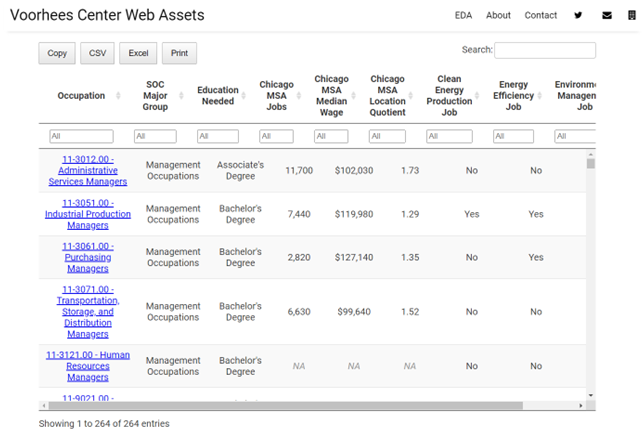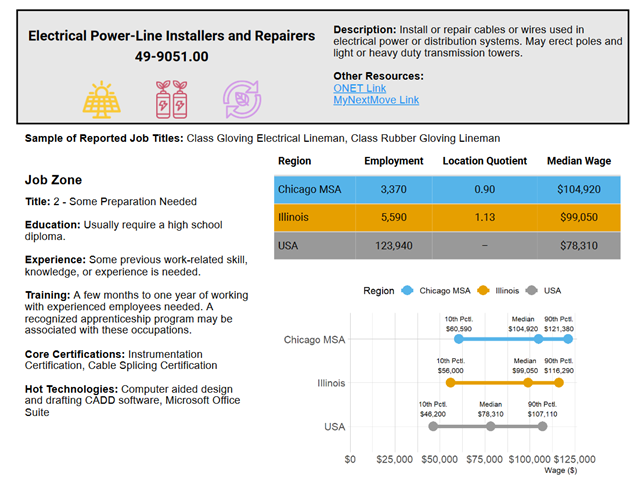The Chicago Metropolitan Area’s Green Economy: Occupation One-Pagers

Introduction
Earlier this summer, the Voorhees Center released the Chicago’ Region’s Clean Energy Economy, Studying Changes in Employment Since 2011 (2022) report. At the regional level, the Green Economy (comprised of Clean Energy Production, Energy Efficiency, and Environmental Management sectors) grew faster, and was more resilient during the onset of the pandemic than the Total Economy. The outlook across industries varied. Energy Efficiency sectors, including Architectural Services and Heating, Ventilation, and Air Conditioning(HVAC) saw marked growth and were a regional specialization. Other sectors, including Semiconductor Manufacturing and Storage Battery Manufacturing, lagged national trends, highlighting the need for concentrated investment.
Green Econ 1
Our study and resource on the green economy workforce provides the necessary complement to the clean energy report by looking at the workforce needed to fill tomorrow’s Green Economy jobs: What do these jobs entail? What kind of preparation is needed? What are the technological skills required?
One Pagers

As noted by the Brookings Institution report Advancing Inclusion Through Clean Energy Jobs (2019),the labor associated with the clean energy economy ranges from assembly-line workers manufacturing energy-saving products to tradesman constructing energy-efficient buildings to technicians operating renewable energy facilities. The projected expansion of the clean energy sector has significant implications on regional labor markets. The Brookings Institute identified 320 unique occupations in 11 Major Groups that comprise the Green Economy. The different occupations that make up the Green Economy are incredibly broad, ranging from skilled manufacturers and technicians to financial and business support services.
Building on this methodology, the Voorhees Center developed an interactive tool that allows users to download one-pagers summarizing key information about Green Economy occupations in the Chicago Region. These one-pagers utilize the US Department of Labor’s ONET Database, the nation’s main source for occupational data, and the Bureau of Labor Statistics (BLS) Occupational Employment and Wage Statistics (OEWS), which provides annual employment and wage estimates. Detailed economic data from OEWS are available for 264 of the 320 occupations in the Green Economy (83%), documenting information on Job Zones, technologies, certifications, employment, and the main tasks associated with the job.
Sample one pager

The one-pagers combine general information about the occupation with a regional economic outlook. For example, those interested in Electrical Power-Line Installer and Repairer jobs can find a brief description about the job and quickly see that the occupation offers a significant economic opportunity. Electrical Linemen usually do not require a four-year college degree, with the main preparation component coming via training and certifications, and the median wage for the job at the state and regional level is much higher than the national rate. The resource just completed provides information similar to what is displayed below for 264 unique green economy occupations.
For more information on how to read these one-pagers and utilize the interactive tool, please follow the link below!
Check Out the One-Pager Tool
Modified on August 28, 2023